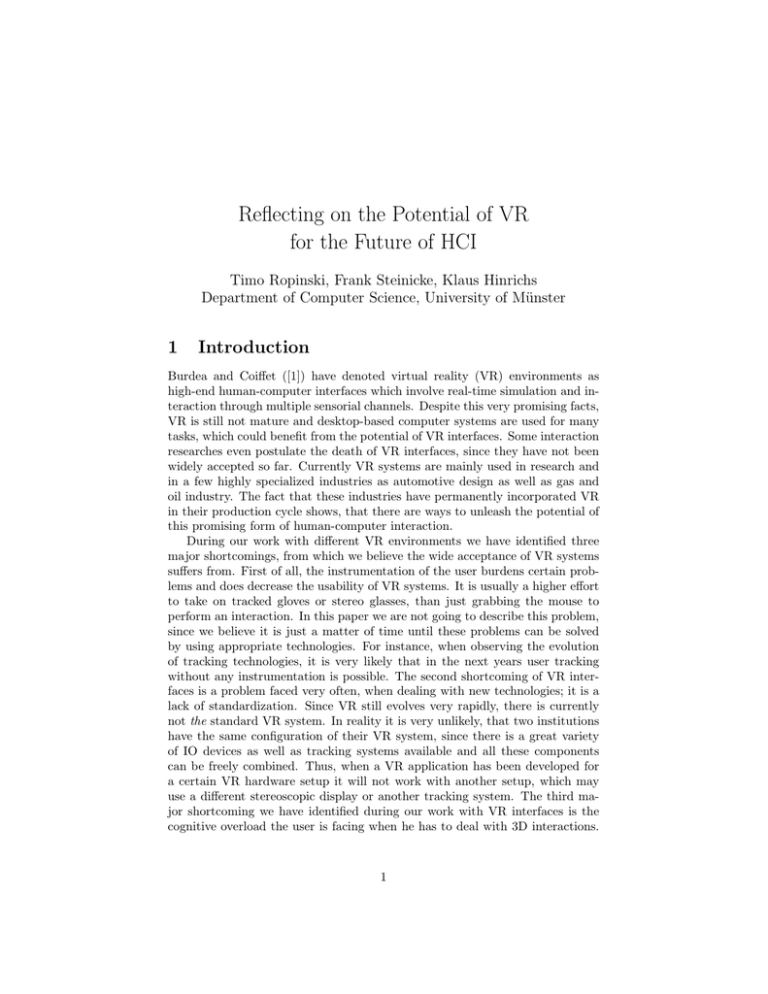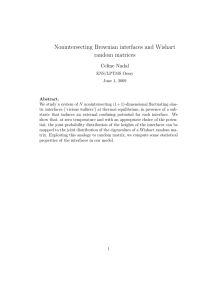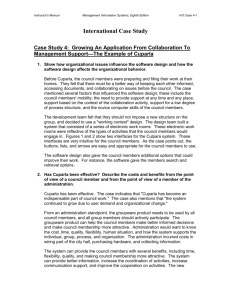Reflecting on the Potential of VR for the Future of HCI 1 Introduction
advertisement

Reflecting on the Potential of VR for the Future of HCI Timo Ropinski, Frank Steinicke, Klaus Hinrichs Department of Computer Science, University of Münster 1 Introduction Burdea and Coiffet ([1]) have denoted virtual reality (VR) environments as high-end human-computer interfaces which involve real-time simulation and interaction through multiple sensorial channels. Despite this very promising facts, VR is still not mature and desktop-based computer systems are used for many tasks, which could benefit from the potential of VR interfaces. Some interaction researches even postulate the death of VR interfaces, since they have not been widely accepted so far. Currently VR systems are mainly used in research and in a few highly specialized industries as automotive design as well as gas and oil industry. The fact that these industries have permanently incorporated VR in their production cycle shows, that there are ways to unleash the potential of this promising form of human-computer interaction. During our work with different VR environments we have identified three major shortcomings, from which we believe the wide acceptance of VR systems suffers from. First of all, the instrumentation of the user burdens certain problems and does decrease the usability of VR systems. It is usually a higher effort to take on tracked gloves or stereo glasses, than just grabbing the mouse to perform an interaction. In this paper we are not going to describe this problem, since we believe it is just a matter of time until these problems can be solved by using appropriate technologies. For instance, when observing the evolution of tracking technologies, it is very likely that in the next years user tracking without any instrumentation is possible. The second shortcoming of VR interfaces is a problem faced very often, when dealing with new technologies; it is a lack of standardization. Since VR still evolves very rapidly, there is currently not the standard VR system. In reality it is very unlikely, that two institutions have the same configuration of their VR system, since there is a great variety of IO devices as well as tracking systems available and all these components can be freely combined. Thus, when a VR application has been developed for a certain VR hardware setup it will not work with another setup, which may use a different stereoscopic display or another tracking system. The third major shortcoming we have identified during our work with VR interfaces is the cognitive overload the user is facing when he has to deal with 3D interactions. 1 When performing 3D interactions in reality the user gets different cues from the environment, e.g., the weight of an object he is moving or an obstacle blocking the movement path. Since these cues are not always provided by VR interfaces, the user has to interact in an unnatural environment often leading to confusion. Of course there have been already solutions proposed for the mentioned shortcomings. Specialized hardware devices, e.g., the phantom device can be used to simulate the weight or the texture of virtual objects. However, an application developed for this VR setup cannot be used within a VR environment not supporting haptic feedback. In this paper we will propose a solution for the two last mentioned shortcomings of VR interfaces. We describe our approach for standardizing the development of VR applications in Section 2 and propose concepts for easing 3D interactions in Section 3. 2 Interface-Independent VR Applications In this subsection the contribution for VR2 S as approach of a generic VR software are pointed out. Application specific demands on a VR software system include especially hardware-oriented issues such as support for multisensory output, various input paradigms, or device independence. Also multi-user support for collaborative interaction must be applicable within the VR system. VR2 S meets these requirements and is used in research application and in cooperations with authorities. Since the design of the VR2 S is based on a generic rendering approach of a 3D graphics library, which has been implemented with the purpose to enable rapid development of interactive applications, developers are able to focus on rapid prototyping of interaction and system behavior, which enables a cost-effective implementation of 3D applications. In addition an adequate abstraction for VEs is implemented as well as the synchronization of highly independent modules by a multi-layered application programming interface. The platform independent and modular implementation of VR2 S eases both extensions as well usability and allows an easy porting to other VR systems. Since VR2 S supports all standard formats exchange of content is ensured. Furthermore, VR2 S provides a rendering system independence API, which allows to design VR applications once and to render it with several rendering systems without the need of recoding. In interior design prototyping, for instance, a once modelled scene can be rendered for interactive exploration and sound propagation using OpenGL and OpenAL (see Figure 1). A generic user interface concept allows to develop applications with VR2 S which are not constrained to a specific user interface. The once implemented VR application can be easily used with any existing standard user interface. Thus, the borders between desktop-based and VR applications blur, since there is only one application, which can be used in different environments using different IO devices. 2 Figure 1: The system architecture of VRS ([2]) and its VR-based extension VR2 S consisting of application, graphics and rendering layers. 3 Reducing the Cognitive Overload The enhancement of human-computer interaction in VR requires the availability of intuitive and natural interaction metaphors with which fundamental interaction tasks can be accomplished. Thus, we have developed several multimodal interaction metaphors, which underline the feasibility of the described interaction concepts within VR2 S. For instance, pointing is a gesture fulfilled very easily in everyday life (see Figure 2 (left)). This leads to a wide adaption of pointer metaphors in VR applications. In order to advance the selection and manipulation process of virtual pointer metaphors, we have introduced the improved virtual pointer (IVP) metaphor ([3]). The IVP metaphor allows the user to select a desired object without requiring an exact hit. A straight ray is used to indicate the direction of the virtual pointer, while an additionally visualized bendable ray points to the closest selectable object (see Figure 2 (right)). Thus, the selection process is accelerated since a user can simply perform direct object selection by roughly pointing at desired objects. To further support the user during the interaction we add multimodal feedback. When the curve bends to another object the user perceives a smooth vibration signal, whereby the signal strength increases the nearer the distance between user and object is. In addition, a gentle sound disperses from the position of that object and results in a better spatial cognition about the position of the desired object. This is just one interaction metaphor incorporated into our framework as an easy to use building block. 4 Conclusion In this paper we have stressed three major shortcomings of VR interfaces, which as we believe are preventing VR from being the state of the art human computer interfaces. We expect that the user instrumentation problem is solved in the next years by researchers of other communities, e.g., by inventing new computer vision algorithms, allowing to track a user without the need for markers. But the other two shortcomings standardization of VR interfaces and reduction of 3 Figure 2: Gesture-based selection in everyday life (left), the IVP selection metaphor (right). cognitive overload when performing 3D interactions are tasks which should be faced by the HCI community. The fact that automotive as well as oil and gas industry exploit VR hardware shows, that VR has the potential to be the next generation HCI. However, since there is no standard for VR interfaces the effort of time and money invested by these industries is not easily transferable to other domains. We have presented a possible solution by providing an easy to use VR framework called VR2 S, which incorporates 3D interaction metaphors, which can be used as building blocks. VR2 S fullfills the major demands of VR developers and it has shown its usefulness in industrial and research applications such as city and landscape planing and exploration tools. We do not proclaim VR2 S as a standard but we believe, that this framework could be a step towards a standardization for the development of VR interfaces. We hope that this paper helps to initiate an investigation to solve the described problems to make VR interfaces more usable and maybe becoming the next generation human computer interfaces. References [1] G.C. Burdea and P. Coiffet. Virtual Reality Technology. Wiley-IEEE Press, 2003. [2] J. Döllner and Klaus Hinrichs. A generic rendering system. In Transactions on Visualization and Computer Graphics, 8(2), pages 99–118, 2002. [3] F. Steinicke, T. Ropinski, and K. Hinrichs. Object selection in virtual environments with an improved virtual pointer metaphor. In International Conference on Computer Vision and Graphics (ICCVG), pages 320–326, 2004. 4



